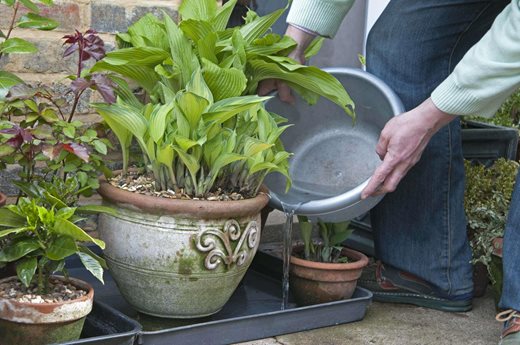
Water matters. Our supplies are coming under pressure from climate change, population increase and the need to protect the environment.
It's important to understand how much water plants actually need, and when and how to water for the best results.
Top tips from RHS Water Scientist Janet Manning
- Install a water butt – these are extremely useful for harvesting rainwater. When rain is forecast, install water butts or clean out your existing ones ready to collect it. If you don’t have one, you can still use watering cans and old bins to collect rainwater.
- Switch to watering in the morning – domestic water use tends to peak in the early evening, so start watering early in the morning to ease the demand later in the day. This will also help provide the water that plants will draw on through the day, and will avoid it just draining away at night.
- Don’t water your lawn – lawns are tough and you may be surprised at how quickly they bounce back after rainfall.
- Swap hoses for a watering can – an hour’s use is equivalent to the average supply for a family of four for two days under normal circumstances. Using a can slows the flow when watering containers, meaning more water stays in the pot rather than running out the bottom.
- Train your plants to drink more slowly by giving them less – using less water will actually encourage the plants to drink less. In essence, if you keep the glass half full, your plants will adapt and learn to drink more slowly.
Water management
Plants need to be watered correctly. There should be enough to wet the top 30cm (12in) of soil, where most plants’ roots should be. Too little water just wets the soil surface and either does not reach the roots or encourages them upwards where they tend to dry out. Too much water will drain out of reach of the roots, or waterlog the soil causing root rot.
With this in mind, it is important to manage the water in a garden to ensure there is an optimal amount all year round.
More on managing water in gardens
More on dealing with drought
Watering baskets and containers
Baskets and containers are notoriously thirsty, making them the most labour-intensive of all watering maintenance. An RHS-funded experiment was set up to look at the best way to water baskets and containers, with important results for all gardeners.
RHS experiment on watering baskets and containers
Using grey water
Domestic waste water, known as 'grey water', may also be used in the garden. This may be from the kitchen, the washing machine or baths, basins and showers. It should be used with care, but can be useful during times of water shortage.
Advice on how to use grey water
